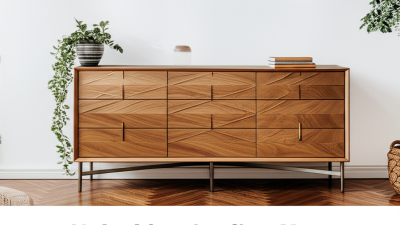In today's rapidly evolving furniture market, sourcing the best modern dressers has become an essential task for both retailers and consumers alike. With a myriad of styles, materials, and finishes available, understanding the industry production standards is crucial for making informed decisions. This ultimate checklist serves as your guide to navigating the complexities of modern dressers, ensuring that you prioritize quality while meeting current design trends. From durable construction to sustainable sourcing practices, we will explore the essential criteria you need to consider when selecting modern dressers globally. Unlock the secrets to quality furniture shopping and elevate your space with the perfect dresser that combines functionality and aesthetic appeal.

As we look toward 2025, the landscape of dresser manufacturing is evolving rapidly, driven by emerging innovations that prioritize quality, sustainability, and design. The integration of advanced materials such as eco-friendly composites and smart textiles is reshaping how modern dressers are produced. Manufacturers are increasingly leveraging data-driven insights to understand consumer preferences, allowing them to tailor designs that meet the expectations of a diverse global market.

Moreover, technology is playing a pivotal role in the production process, with automated systems enhancing efficiency and accuracy. Innovations like 3D printing are becoming more prominent, enabling custom designs without the waste typically associated with traditional manufacturing methods. This shift not only reduces environmental impact but also caters to the growing demand for personalized furniture solutions.
As we approach 2025, it's clear that the future of dresser manufacturing is not just about aesthetics; it is also about integrating innovative technologies to deliver high-quality, sustainable products that resonate with modern consumers.
In recent years, the dresser market has been significantly influenced by sustainability trends, with eco-friendly materials gaining traction among manufacturers and consumers alike. A comprehensive industry analysis indicates that the demand for sustainable furniture is projected to increase, with an anticipated growth rate of over 10% annually. This shift is largely driven by consumers’ rising awareness of environmental issues and their preference for products made from responsibly sourced materials.
Moreover, the use of sustainable materials, such as reclaimed wood, bamboo, and low-VOC finishes, not only appeals to eco-conscious buyers but also enhances the durability and aesthetic quality of modern dressers. Reports suggest that the market share of dressers made from eco-friendly materials is poised to expand as retailers increasingly prioritize sustainability in their product offerings. For instance, the global market for sustainable furniture is estimated to reach approximately $500 billion by 2030, showcasing a growing appetite for responsible consumption that is reshaping the dresser segment within the broader furniture industry.
In the world of modern dressers, smart technology is revolutionizing not only design but also functionality. As consumers increasingly seek versatile and aesthetically pleasing furniture, the integration of technology has become a pivotal factor. With features such as built-in lighting, Bluetooth connectivity, and voice-activated controls, modern dressers are transcending their traditional roles. These advancements allow users to personalize their storage solutions while enhancing the overall user experience.
When sourcing the best modern dressers, consider these tips: First, evaluate the technology features that matter to you. A dresser equipped with smart functionalities can simplify everyday tasks. Look for models that offer customizable settings and connectivity options that fit seamlessly into your smart home ecosystem. Second, don't overlook the importance of materials and design. High-quality materials not only enhance aesthetics but also ensure longevity. Lastly, read customer reviews to better understand how these technologies perform in real-life scenarios.
As brands strive to meet the rising demand for innovative solutions, the future of modern dressers looks exceptionally bright, promising a blend of utility and artistry that resonates with today's consumers.
In the ever-evolving dresser industry, global sourcing strategies are paramount to ensuring quality and efficiency. Key markets such as Asia, particularly regions with robust manufacturing capabilities, offer a plethora of potential suppliers. Countries like Vietnam and India are rapidly emerging as favorable destinations for sourcing modern dressers, thanks to their combination of skilled labor and competitive pricing. These markets not only meet the increasing demand for stylish and functional dressers but also present opportunities for innovative designs that cater to diverse consumer preferences.
As businesses look to enhance their supply chain management, integrating advanced technologies like deep learning and machine learning can significantly improve supplier selection and production processes. By leveraging these technologies, companies can analyze market trends, forecast demands, and streamline inventory control. This strategic approach not only supports sourcing high-quality dressers but also fosters sustainable practices by reducing waste and optimizing resources efficiently. Embracing these global sourcing strategies and technological advancements will undoubtedly position brands at the forefront of the modern dresser market.
When sourcing modern dressers globally, implementing quality control essentials is crucial. Establishing clear metrics and standards will help you evaluate each piece effectively. Focus on material quality, craftsmanship, and design to ensure the availability of durable and aesthetically pleasing products. Remember, the right materials not only enhance durability but also reflect the brand’s commitment to quality.
Tip 1: Develop a standardized checklist for assessing dressers. Include points such as wood type, joinery techniques, finish quality, and hardware reliability. This checklist will guide your inspections and comparisons, allowing for consistent evaluations across different suppliers.
Tip 2: Don’t overlook customer reviews and ratings. Analyze feedback related to the dresser's usability, longevity, and overall satisfaction. This qualitative data can provide insights into how the product performs in real-world situations, offering invaluable information that metrics alone may not reveal.
By adhering to these quality control essentials, you can make informed decisions and select the best modern dressers that meet your standards and customer expectations.
